PHYS341/2024/Project30
Background
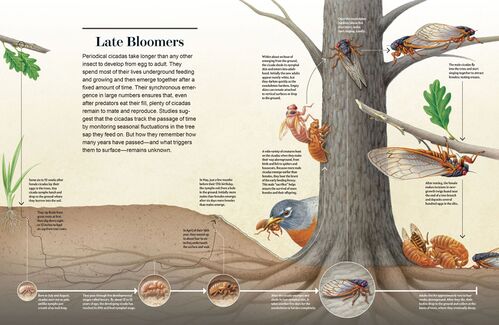
Cicadas are often renowned for their ability to produce sounds that are compared to that of a melodious song. One particular species, Cyclochila australasiae, was measured at a distance of 20 cm to produce up to 115 dB or the equivalent of the sound levels found in nightclubs.[2][3] Later studies on C. australasiae would show their songs to be at a frequency of 4300 Hz.[4] On a musical scale, this would be the equivalent of a note between a C8 and a C#8.[5] Only male cicadas are able to sing, as females do not possess a tymbal: the predominant organ in sound production. The main purpose of singing in cicadas is to function as a mating call for males to attract females. Unlike the typical life cycle of an insect, cicadas spend a significant portion of their lifespan in the ground before reemerging from the ground to mate and breed. The time spent underground varies species by species but species belonging to brood XIX remerge every 13 years, while species belonging to brood XIII remerge every 17 years. The year 2024 is particularly significant as both broods XIII and XIX are thought to co-emerge for the first time since 1803.[6]
Mechanism of Sound
The singing mechanism of cicadas relies on the production of sound waves through the disruption of a membrane, the subsequent resonance of sound through an air cavity and the radiation of sound through the body and onto the surrounding air molecules.
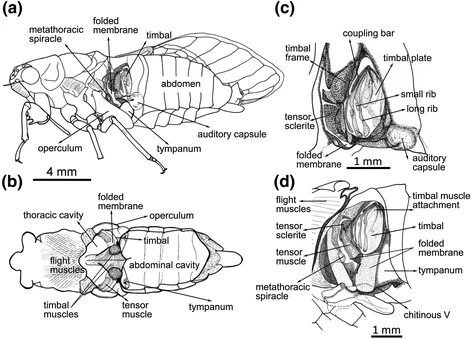
The creation of sound in cicadas occurs from the contraction and relaxation of tympanic muscles connecting to a membrane: the tymbal. The contraction of the muscle causes the bending of the tymbal, while the relaxation of the muscle results in the tymbal returning to its equilibrium position. This process repeated in quick succession, results in the production of a clicking sound.
Anatomically, the tymbal and the tympanic muscles are located in the abdomen of the cicada. As the abdomen is relatively hollow, it physically acts as a resonator for sound amplification. Although it is easy to focus on the tymbal and its tympanic muscles as the sole unit of a cicada’s singing capabilities, it should be noted that the positioning of the abdomen and the air sac are also detrimental in enhancing and propagating the sound to surrounding air molecules.[8] As such, the entire cicada can be thought of as nature's musical stringed instrument.
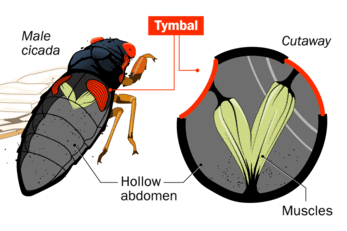
This method of sound production is remarkably similar to that of a stringed instrument like a violin. The disruption of the tymbal membrane by the tympanic muscles is equivalent to the plucking of strings on a violin. The production of sound occurs when the tymbal returns to its equilibrium position after disruption. Like a violin, the plucking of the string does not create much sound by itself. Rather, the plucked string transfers energy from the bridge of the instrument to the body of the instrument and its air cavity to produce an audible sound. In the cicada, the energy from the bending and recovering of the tymbal is transferred into the body cavity, where it undergoes amplification through resonance in the air cavity before contacting the outer air molecules.
The Correlation Between Size and Frequency
By understanding that sound production from the bending and unbending of the tymbal is synonymous to the plucking of a string. The equation for the wave speed of a stretched string is applicable to determining the effects of a longer and wider tymbal. If the composition of the tymbal remains the same, a wider or thicker tymbal would result in an increase in tension force. This could be explained by a thicker tymbal containing more mass than a thinner tymbal and the resulting relationship between mass and tension. As tension is proportional to frequency, this would indicate that a larger cicada would fundamentally sing at a higher frequency. While a smaller cicada with a smaller and thinner tymbal would sing at a lower frequency.
Utilizing Audacity, the sounds of different sized cicadas and their generalized song frequencies can be measured and compared.
Tibicen canicularis or the dog day cicada has an usual adult size ranging from 27 mm to 33 mm.[10]

8 wave cycles in 0.031 (7.875-7.855) = 8/0.031 = 258 Hz
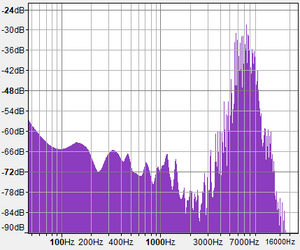
Neotibicen pruinosus or the scissor grinder cicada has an usual adult size ranging from 50 mm to 56 mm.[12]

8 wave cycles in 0.024 (12.708-12.684) seconds = 8/0.024 = 333 Hz
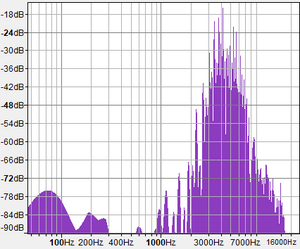
The frequency was calculated by measuring the amount of time it takes for 8 wave cycles to occur. In the dog day cicada time graph, the completion of 8 wave cycles takes 0.031 seconds to occur, leading to a frequency of 258 Hz. In the scissor grinder cicada, 8 wave cycles take 0.024 seconds to occur, leading to a frequency of 333 Hz. These values match with the hypothesis that a bigger cicada, such as the scissor grinder cicada, would sing at a much higher frequency due to the greater tension force on the tymbal membranes.
References
- ↑ "Brood X Cicadas Are Emerging at Last".
- ↑ "Occupational Noise Exposure".
- ↑ "Do Cicadas Radiate Sound Through Their Ear-drums". The Journal Of Experimental Biology.
- ↑ "How Cicadas Make Their Noise". Scientific American.
- ↑ "Frequencies for equal-tempered scale, A4 = 432 Hz".
- ↑ "The 2024 Periodical Cicada Emergence".
- ↑ "Insect Hearing and Acoustic Communication". Animal Signals and Communication.
- ↑ "Do Cicadas Radiate Sound Through Their Ear-drums". The Journal Of Experimental Biology.
- ↑ "An Animated Guide to This Year's Massive Brood X Cicada Emergence".
- ↑ "Dog Day Cicada (Tibicen canicularis)".
- ↑ "Dog-day Cicada (Neotibicen canicularis)".
- ↑ "Scissor Grinder Cicada (Neotibicen pruinosus)".
- ↑ "Scissor-grinder Cicada (Neotibicen pruinosus pruinosus and winnemanna)".